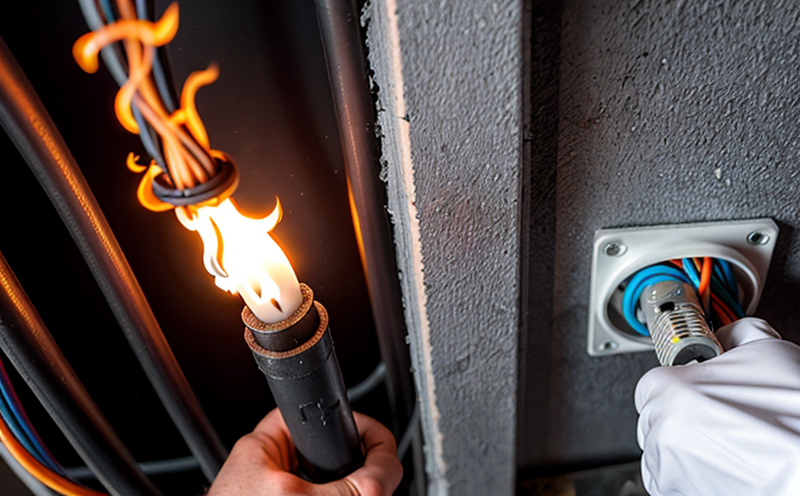IEC 60332-3-22 Flame Test on Bunched Cables
The IEC 60332-3-22 standard is a critical part of the family of test methods for assessing fire resistance in electrical and electronic wiring, cables, and related components. This particular standard focuses specifically on bunched cables, addressing their potential to contribute to the spread of fire when installed in complex installations such as data centers or industrial facilities.
The IEC 60332-3-22 test is designed to evaluate how well a cable will withstand flame propagation under specific conditions. This is particularly important for bunched cables, which are often used in high-density environments where the spread of fire can be exacerbated by the close proximity and arrangement of multiple conductors.
During the IEC 60332-3-22 test, a sample cable or group of cables is subjected to a controlled flame. The key parameters include the type of flame used (e.g., an open flame or a gas torch), the duration of exposure, and the distance between the flame source and the specimen. The test is conducted in accordance with international standards such as ISO/IEC 60332-3-22:2018.
The goal of this testing procedure is to determine whether the cable can prevent or delay the spread of fire beyond a specified distance from the flame source. This helps ensure that even in the event of a small ignition, the cable will not contribute significantly to the overall fire hazard. Compliance with IEC 60332-3-22 is mandatory for cables intended for use in potentially hazardous environments where fire resistance is critical.
The test setup typically involves a sample of bunched cables placed on a support structure within a specially designed chamber. The chamber is equipped with precise temperature and flame control systems to ensure that the test conditions are reproducible and consistent across multiple samples. After the flame application, the specimen is carefully examined for any signs of burning or melting beyond the specified distance.
The acceptance criteria for this test are stringent, requiring that the cable either prevent or significantly delay the spread of fire under defined conditions. This ensures that even in the event of a small ignition source, the cable will not contribute to the rapid spread of flames and smoke, which could lead to more severe fires and potential casualties.
Understanding the context of this test is essential for quality managers and compliance officers who must ensure that their products meet stringent safety standards. R&D engineers can leverage this information to refine product designs and improve fire resistance performance. For procurement professionals, ensuring adherence to these standards is crucial to maintaining a high level of safety across all materials used in critical applications.
Compliance with IEC 60332-3-22 is not just about meeting regulatory requirements; it's also about demonstrating a commitment to the highest levels of safety and reliability. By adhering to these standards, manufacturers can ensure that their products are suitable for use in environments where fire resistance is paramount.
The test procedure itself is designed to be rigorous and replicable, with precise specifications regarding specimen preparation, flame application methods, and observation criteria. This ensures consistency across different laboratories and testing facilities, making it easier to compare results and validate product performance.
Benefits
- Enhanced safety for personnel working in hazardous environments
- Reduction of fire risk in industrial settings such as data centers and manufacturing plants
- Increased confidence in product performance during emergencies
- Facilitation of easier compliance with international standards
- Improved brand reputation through adherence to rigorous testing protocols
- Potential for cost savings by preventing more severe fires and associated damages
- Enhanced regulatory approval processes due to proven safety measures
International Acceptance and Recognition
The IEC 60332-3-22 flame test on bunched cables is widely recognized and accepted across the globe. Its acceptance is particularly significant in industries where fire safety is a critical concern, such as data centers, telecommunications, and industrial facilities.
Many countries have adopted this standard into their national regulations for electrical wiring and cable installations. This ensures that manufacturers and installers are held to the same high standards of safety wherever they operate. The acceptance of IEC 60332-3-22 also facilitates international trade, as products meeting these standards can be sold in multiple markets without requiring additional testing.
The standard's widespread adoption is a testament to its effectiveness and reliability. By adhering to this standard, companies demonstrate their commitment to safety and regulatory compliance, which is increasingly important in an interconnected global market.
Use Cases and Application Examples
| Use Case/Application Example | Description |
|---|---|
| Data Center Cabling | Bunched cables in data centers are subjected to rigorous testing to ensure they do not contribute to fire hazards during emergencies. |
| Telecommunications Infrastructure | In telecommunications networks, bunched cables must be tested for their ability to withstand flame propagation and prevent the spread of fires. |
| Industrial Manufacturing Facilities | Manufacturing plants with complex wiring systems benefit from IEC 60332-3-22 testing to ensure fire resistance in critical areas. |
| Hospital Electrical Systems | In healthcare facilities, bunched cables are tested for their ability to prevent the spread of fires and protect lives during emergencies. |
| Residential Wiring Upgrades | For homes undergoing wiring upgrades, compliance with IEC 60332-3-22 ensures that fire safety is not compromised in densely populated spaces. |





